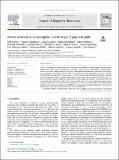Neural networks in pulsed dipolar spectroscopy : a practical guide
Abstract
This is a methodological guide to the use of deep neural networks in the processing of pulsed dipolar spectroscopy (PDS) data encountered in structural biology, organic photovoltaics, photosynthesis research, and other domains featuring long-lived radical pairs and paramagnetic metal ions. PDS uses distance dependence of magnetic dipolar interactions; measuring a single well-defined distance is straightforward, but extracting distance distributions is a hard and mathematically ill-posed problem requiring careful regularisation and background fitting. Neural networks do this exceptionally well, but their “robust black box” reputation hides the complexity of their design and training – particularly when the training dataset is effectively infinite. The objective of this paper is to give insight into training against simulated databases, to discuss network architecture choices, to describe options for handling DEER (double electron-electron resonance) and RIDME (relaxation-induced dipolar modulation enhancement) experiments, and to provide a practical data processing flowchart.
Citation
Keeley , J , Choudhury , T , Galazzo , L , Bordignon , E , Feintuch , A , Goldfarb , D , Russell , H , Taylor , M J , Lovett , J E , Eggeling , A , Fabregas Ibanez , L , Keller , K , Yulikov , M , Jeschke , G & Kuprov , I 2022 , ' Neural networks in pulsed dipolar spectroscopy : a practical guide ' , Journal of Magnetic Resonance , vol. 338 , 107186 . https://doi.org/10.1016/j.jmr.2022.107186
Publication
Journal of Magnetic Resonance
Status
Peer reviewed
ISSN
1090-7807Type
Journal article
Description
This work was funded by a grant from Leverhulme Trust (RPG-2019-048). Studentship funding and technical support from MathWorks are gratefully acknowledged. This research was supported by grants from NVIDIA and utilised NVIDIA Tesla A100 GPUs through the Academic Grants Programme. We also acknowledge funding from the Royal Society (University Research Fellowship for JEL) and EPSRC (EP/R513337/1 studentship for HR and EP/L015110/1 studentship for MJT).Collections
Items in the St Andrews Research Repository are protected by copyright, with all rights reserved, unless otherwise indicated.

